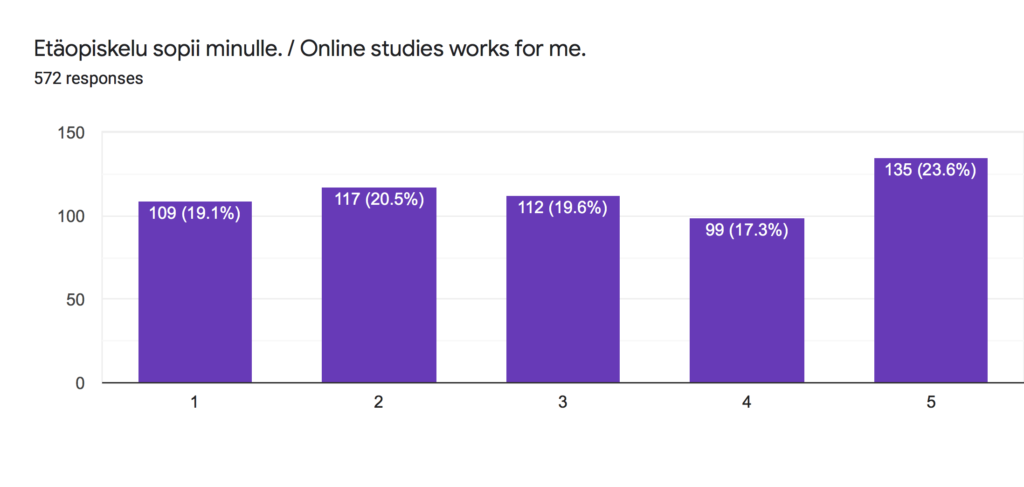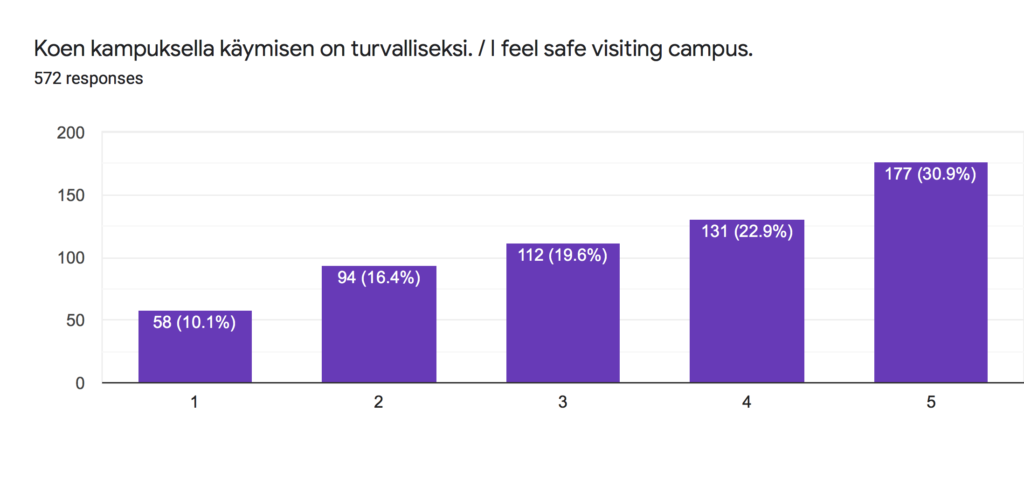Survey coordinated by HAMKO
In the autumn, when the corona situation worsened again nationwide, HAMK decided to continue implementing a so-called hybrid model in teaching. In hybrid model, only the necessary studies are carried out as contact teaching on campuses. The student union (HAMKO), together with the local student associations from HAMK campuses, conducted a survey about the implementation of the hybrid model.
A total of 572 responses were received to the survey. 31.1 % of respondents were first-year students, 40.4 % second-year students, 23.4 % third-year students, and the remaining fourth- or more-than-fourth-year students. Most respondents were full-time students at 79.5 % and the remaining 20.5 % at part time students.
In the survey we asked about the following themes considering hybrid model and studying remotely:
- study motivation
- experiences of distance learning
- the progress of studies when studying the hybrid model
- wishes to increase contact teaching
- the experience of campus safety and
- the opinion of HAMK’s communication about the corona guidelines.
Respondents were asked to rate the validity of six statements on their own on a scale of 1 to 5 (1 strongly disagree, 2 somewhat disagree, 3 disagree and disagree, 4, somewhat agree, and 5 strongly agree). The statements were:
- My motivation is good.
- Online studies work for me.
- My studies have progressed in planned time.
- I would like to have more contact lessons.
- I feel safe visiting campus.
- Communication about Covid-19 has been good.
In addition, students had the opportunity to give feedback and supplement their answers.
Survey results
Most of the respondents felt that their study motivation was good. 32.7 % of respondents somewhat agreed and 23.6 % completely agreed with the statement “my motivation is good”. Only 5.8 % said that they strongly disagree with the statement.
Regarding the suitability of studying remotely, the variance of the answers was large and evenly distributed between all answer options:

Most of the respondents answered that their studies have progressed on schedule. 46.2 % of the respondents completely agreed with the statement, and 26.4 % of the respondents somewhat agreed.
A total of 56.2 % of the respondents were in favor of increasing contact teaching, with 39.2 % strongly agreeing and 17 % somewhat agreeing.
When asked about campus safety, the answers were evenly distributed between the different answer options:

Most of the respondents considered HAMK’s communications about corona to be successful and good. 33.7% strongly agreed and 37.1% somewhat agreed with the statement.
Free-form answers to the open question
186 respondents gave free-form feedback to the question “Praises or things to improve? You can make an argument for your answers”. We have classified the responses to three groups: positive (green), neutral (yellow), and negative (red).

The open feedback highlighted three themes in particular: teaching materials and practices, and communication.
Respondents criticized the distribution of teaching remotely and on campus. Students will have to go to campus for a single lecture in the middle of the day and then return home to remote learning. The model was perceived as chaotic and stressful. Many hoped that teaching on campus would be placed on a schedule, for example, so that students would be at school in the beginning week and spend the rest of the time studying at home.
Many described how, for example, in language teaching, teaching focuses on oral exercises done in small groups. The problem is that the differences in students’ competences has not been taken into account well enough in the teaching. This has caused dissatisfaction, as those who already speak the language do not get the challenge they need and reciprocally those who need more help and support don’t get it.
A few responses mentioned that there are no breaks or possibilities to ask questions during online lectures. The problem does not seem to be general, but we want to highlight it because it is easy to influence. When there are enough breaks during a lecture, it is easier for students to stay focused.
The distance learning materials were criticized for being just collections of links to different sites and did not seem like entities designed specifically for that module or implementation.
Hybrid model and studying remotely also made studying easier for some students. For example, the combining studies and work has become easier with distance learning, when assignments can be done when it suits the student best. In addition, a few respondents mentioned that it reduces stress caused by corona situation when there is no need to stress about going to campus. A few respondents also praised that when contact teaching has been organized, the arrangements have been good. For example, there has been masks available for everyone.
HAMK’s communication about the corona situation and measures received praise, but also criticism. Respondents praised the prompt communications and the fact that enough information has been available at Yammer. Critics of communication gave feedback on the vagueness of communication and that corona guidelines have not been sufficiently justified for students. Regarding communication, it was also commented that it is difficult to communicate with teachers and study counselors as e-mails are answered slowly.
Summary
In summary, students experience hybrid model and studying remotely in very different ways. Most respondents felt that the hybrid model was largely a workable and good solution, and the extremely negative experiences were in the minority. However, many respondents highlighted problems in various areas that need to be addressed and that require action. This way we can make studying at HAMK as smooth as possible, not only during these exceptional times but also thereafter.
